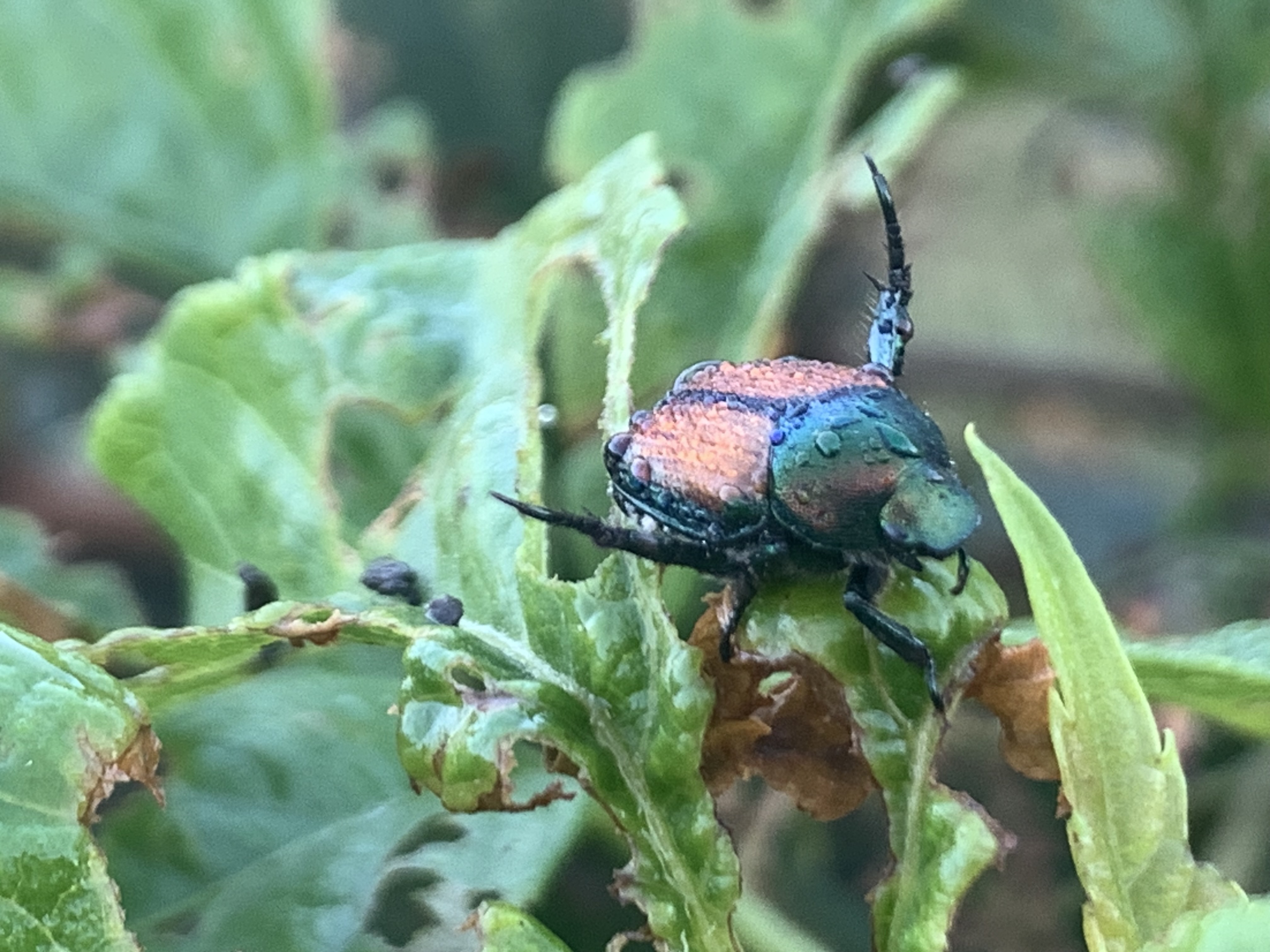There’s a bunch of Virginia creeper growing on the fence down by the barn. Many of their leaves have been surgically stripped of the softer tissue between the veins, leaving lacy skeletons behind. A closer look reveals the culprits–a dozen or so half-inch-long, metallic green beetles with copper-colored wing cases and little white tufts of hairs along their sides. These are the dreaded Japanese beetles (Popillia japonica). They first made their way to the United States in a ship in 1916. They landed in Riverton, New Jersey. Heeding Horace Greeley’s recommendation to “go west, young man, go west,” they began to creep westward. Seventy-eight years later, in 1994, they crossed the Mississippi into Iowa. They were not welcome. Their feeding habits as grubs and as adults do not endear them to any gardener, farmer, landscaper, arborist or turf manager. And most of the natural controls that keep them in check in their native Japan are absent on Owl Acres.
The adults will eat the leaves, flowers and fruits of over 350 species of trees and plants. On Owl Acres, they find some of their favorite trees—black walnuts, elms, apple and cherry along with wild grape, poison ivy, and multiflora rose. They’re not quite so fond of boxelder, red cedar, lilac, red maple, mulberry and oak. That said, they can defoliate a tree in short order, leaving just leaf skeletons. Most mature trees can withstand this onslaught and will leaf out again either in the fall or the next spring. The beetles can sound the death knell though for Young or damaged trees. They can also destroy a garden in short order, eating the leaves and flowers of everything in sight. They will attack grasses, ornamentals, vegetables, flowers, and everything else they can find.

Japanese beetle feeds on skeletonized river grape leaf. Insect has metallic green thorax plate, copper colored elytrons (forewings hardened into protective covers, giving the beetle its characteristic rounded body shape) and tufts of short white hairs along its abdomen
But it’s not just the adults that wreak havoc. The grubs, little pale C-shaped larvae, live below the surface and eat roots. The grass will die in infected areas because the roots are gone. You can roll up the grass like a rug when the grubs get done with it. No wonder nobody loves them!
The adults emerge in late June or July and start chowing down. They mate and continue to feed until frost. Meanwhile the females burrow a few inches into the soil and lay 30 to 60 little spherical eggs in moist places. A couple of weeks later the eggs hatch. The grubs immediately start eating plant roots. When the frost comes, they will burrow into the ground from eight to twenty inches deep and overwinter. When the ground temperature reaches 50 degrees in the spring, they rise up and resume their voracious feeding on plant roots. When they’re about an inch long, they dig a little cavity in the soil and pupate, emerging eight to 20 days later as adults to start the cycle over again.
The U.S. Department of Agriculture has initiated a program that trains dogs to sniff out these beetles and lantern flies, another invasive. The hope is that finding them early might make it possible to control them before they spread farther. They’ve already made it to the Rockies, so it’s too late for Owl Acres.
Some Japanese wasps and flies are natural predators of these beetles in their homeland. Some of these predators have been imported to the United States to try to help control them here. Meanwhile, the beetles make crunchy snacks for moles, shrews, skunks and birds. A bacterium, (Bacillus popilliae” causes something called milky disease in the larvae which also helps control the population of Japanese beetles. If you don’t want them in your garden, you may have to hand-pick them and drop them into soapy water. You can also put nets over your most precious plants to keep them off.
As the climate warms, these beetles are expected to shift their territory northward into Canada. And the wasps and flies and bacteria we’ve imported to help control them? Will they stay in their lane and focus on the beetles? Or, like so many other imports, will they branch out in unexpected directions? Time will tell.
Photo by Author. Alt text: Dew-covered Japanese beetle sits on a Virginia creeper leaf, waiting for the morning sun to dry it off.

3 comments
Nasty things for sure!!! Not welcome here, but I have them. Unfortunately!
I absolutely hate Japanese Beetles. We used to have such beautiful roses and I always had roses for in the house. But, these beetles have pretty much put an end to that. Joe would go out every day and pick them off the roses and kill them. The next day, there were just tons more. He finally gave up trying to save the roses.